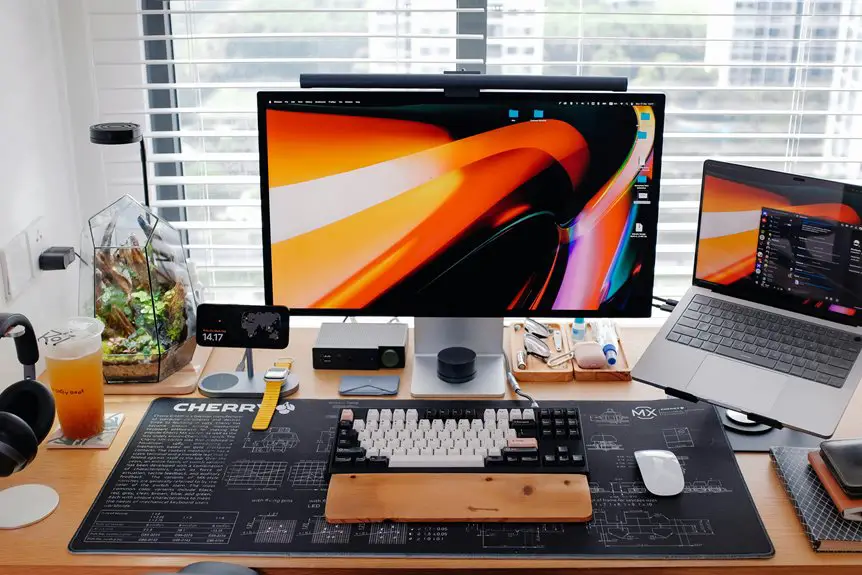To use a trackball mouse with your laptop stand, place the mouse on a stable, level surface and connect it via USB or Bluetooth. Adjust your laptop stand to ensure the screen is at eye level while keeping the stand at a comfortable angle for your wrists. Customize the mouse's sensitivity for better control and test its movements. By following these steps, you'll enhance your ergonomic setup and productivity—there's more useful information ahead to optimize your experience!
Table of Contents
Key Takeaways
- Connect your trackball mouse to the laptop via USB or Bluetooth for seamless operation.
- Place the trackball mouse on a stable surface for optimal maneuverability and control.
- Adjust the laptop stand height to align the screen with your eye level for better posture.
- Customize the mouse's sensitivity and button functions for enhanced user experience and efficiency.
- Regularly clean the trackball and sensor area to maintain smooth performance and responsiveness.
Understanding the Trackball Mouse
A trackball mouse is a unique input device that puts the control right at your fingertips. Unlike a traditional mouse, you don't move the whole device; instead, you rotate the ball to navigate your screen. This design allows for precise movements with minimal wrist strain, making it great for long hours of use.
To use it, position your fingers on the ball and gently roll it to direct the cursor. The buttons, usually found around the ball, perform clicks just like a standard mouse.
With practice, you'll find it intuitive and responsive. Remember, you can customize the sensitivity settings to suit your preferences, ensuring a comfortable and efficient experience.
Embrace this innovative tool, and you'll enhance your productivity in no time!
Benefits of Using a Trackball Mouse With a Laptop Stand
Using a trackball mouse with a laptop stand can significantly enhance your ergonomic setup. This combination allows you to maintain a comfortable posture while reducing strain on your wrists and forearms. Since the trackball stays stationary, you don't have to reach for a traditional mouse, which can lead to awkward angles and discomfort.
Additionally, a laptop stand raises your screen to eye level, promoting better neck alignment. Together, these tools help you create a more efficient workspace.
You'll also find improved precision with the trackball, making it easier to navigate complex tasks. Ultimately, this setup can boost your productivity and overall comfort during long hours at your laptop. It's a simple yet impactful upgrade!
Setting Up Your Trackball Mouse
Setting up your trackball mouse is a straightforward process that can enhance your computing experience.
First, connect the trackball mouse to your laptop using either a USB cable or Bluetooth, depending on your mouse type. If you're using a USB mouse, plug it into an available port. For Bluetooth, enable Bluetooth on your laptop and pair the devices by following the prompts.
Next, place the trackball mouse on a stable surface, ensuring you have enough space to maneuver.
If your trackball mouse has adjustable settings, consider customizing the sensitivity and button functions to suit your preferences.
Finally, test the mouse by moving the trackball and clicking the buttons to ensure everything's working smoothly.
You're all set to enjoy a more ergonomic setup!
Adjusting Your Laptop Stand for Optimal Use
With your trackball mouse set up, it's time to ensure your laptop stand complements your ergonomic setup.
Start by adjusting the height of your stand so that your eyes align with the top of the screen. This helps reduce neck strain.
Next, position the stand at a comfortable angle, ideally between 15 to 30 degrees, to keep your wrists straight while typing.
Make sure the laptop's screen is about an arm's length away to minimize eye fatigue.
If possible, use a separate keyboard and place it at a height that allows your elbows to rest comfortably at your sides.
These adjustments will foster a more natural posture, making your trackball mouse experience smoother and more enjoyable.
Techniques for Effective Trackball Control
To master your trackball mouse, you need to focus on proper hand positioning and adjusting the trackball sensitivity.
Finding the right grip will enhance your control and comfort during use.
Once you're set up, tweaking the sensitivity can help you navigate your screen with precision.
Proper Hand Positioning
Achieving proper hand positioning is crucial for mastering a trackball mouse. It ensures smooth control and reduces strain, making your experience enjoyable.
Here's how to position your hand effectively:
- Relax your fingers: Keep them gently resting on the ball, allowing for natural movement.
- Maintain a neutral wrist: Your wrist should be straight, not bent, to prevent discomfort during long sessions.
- Use your thumb for navigation: Rely on your thumb to roll the ball smoothly while your other fingers provide stability.
Adjusting Trackball Sensitivity
Proper hand positioning sets the foundation for effective trackball use, but adjusting the sensitivity can greatly enhance your control.
Start by accessing your computer's mouse settings; you'll typically find sensitivity options under "Pointer Options" or "Mouse Properties." Increase sensitivity if you want quicker responses with less movement, or decrease it for more precision and slower movements.
Experiment with different levels to find what feels comfortable for you. Remember to keep your hand relaxed while using the trackball, as tension can affect your accuracy.
Once you've adjusted the sensitivity, practice with various applications to fine-tune your settings. Don't hesitate to make further adjustments as you get used to the trackball's unique feel and responsiveness.
Troubleshooting Common Issues
Although trackball mice can enhance your productivity, they may sometimes encounter issues that hinder their performance. If you're experiencing problems, don't panic!
Here are some common concerns you might face and quick fixes to try:
- Ball Sticking: Dirt and debris can accumulate, causing the ball to stick. Regularly clean the ball and its housing to keep it smooth.
- Unresponsive Cursor: If your cursor isn't responding, check your connection—make sure your USB is plugged in securely or try a different port.
- Erratic Movement: This can happen due to a dirty sensor. Clean the sensor area gently with a soft cloth for better tracking.
Maintaining Your Trackball Mouse for Longevity
To keep your trackball mouse in top shape, you need to adopt some regular maintenance habits.
This includes cleaning it often, storing it properly, and staying updated with software improvements.
Regular Cleaning Practices
Regular cleaning practices are essential for maintaining the longevity of your trackball mouse. Dust and grime can build up quickly, affecting its performance.
By incorporating simple cleaning routines, you can ensure smooth operation and prolong its life. Here's how to keep your trackball mouse in top shape:
- Wipe the outer surfaces: Use a microfiber cloth to remove fingerprints and smudges.
- Clean the trackball: Regularly remove and rinse the ball under warm water, letting it dry completely before reinserting.
- Check for debris: Inspect the mouse's interior for dirt and lint, using a soft brush to dislodge any buildup.
These small actions make a big difference in your trackball mouse's performance and efficiency.
Proper Storage Techniques
Proper storage techniques can significantly impact the longevity of your trackball mouse. When you're not using it, store the mouse in a cool, dry place to prevent moisture damage.
Avoid placing it directly on surfaces that can scratch or damage the trackball; instead, use a soft cloth or a protective case. If your trackball mouse has a removable ball, take it out for storage to reduce friction and wear.
Keep the mouse away from direct sunlight, which can warp plastic components. Lastly, ensure the cord is coiled loosely if it's wired; tight coils can lead to cable damage over time.
Following these steps helps maintain your trackball mouse in optimal condition for years to come.
Software Updates Importance
Keeping your trackball mouse in great shape doesn't just rely on physical care; software updates play a big role too.
Regularly updating the software ensures you're getting the best performance and features. When you neglect updates, you might encounter frustrating issues that could've been easily fixed.
Here's why you shouldn't overlook software updates:
- Enhanced Performance: Updates often optimize your mouse's responsiveness and accuracy.
- Bug Fixes: They address glitches that can disrupt your workflow or lead to frustration.
- New Features: Software updates can introduce exciting functionalities that improve your overall experience.
Frequently Asked Questions
Can I Use a Trackball Mouse With Any Laptop Model?
Yes, you can use a trackball mouse with nearly any laptop model. Just ensure your laptop has the necessary USB ports or Bluetooth capability. It'll provide a comfortable and efficient way to navigate your screen.
How Do I Clean the Trackball and Its Casing?
To clean your trackball and its casing, unplug it first. Remove the ball, wipe the casing with a damp cloth, and clean the ball with mild soap. Dry everything thoroughly before reassembling and using it again.
Are There Trackball Mice Specifically Designed for Gaming?
Yes, there are trackball mice designed specifically for gaming. These models typically feature faster response times, customizable buttons, and ergonomic designs to enhance gameplay. You'll find options that suit both casual and competitive gamers alike.
Will a Trackball Mouse Work on a Glass Surface?
Yes, a trackball mouse can work on a glass surface, but it may not perform as well. You might want to use a mouse pad designed for optical devices to enhance tracking and control.
How Do I Choose the Right Size Trackball Mouse?
When choosing the right size trackball mouse, consider your hand size and comfort. Test different models; a larger ball might suit bigger hands, while a smaller one can be easier to maneuver for smaller hands.




